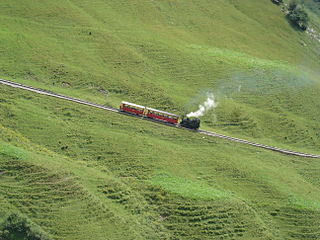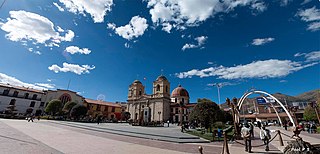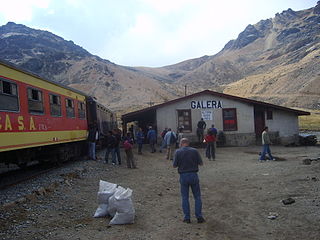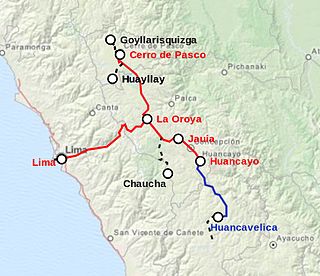This article describes the transport in Peru.

Quechua, also called Runasimi in Southern Quechua, is an indigenous language family that originated in central Peru and thereafter spread to other countries of the Andes. Derived from a common ancestral "Proto-Quechua" language, it is today the most widely spoken pre-Columbian language family of the Americas, with the number of speakers estimated at 8–10 million speakers in 2004, and just under 7 million from the most recent census data available up to 2011. Approximately 13.9% of Peruvians speak a Quechua language.

A mountain railway is a railway that operates in a mountainous region. It may operate through the mountains by following mountain valleys and tunneling beneath mountain passes, or it may climb a mountain to provide transport to and from the summit.

The Lima and Callao Metro is a rapid transit system that serves the cities of Lima and Callao, which make up the Lima metropolitan area. The existing metro lines currently link the district of Villa El Salvador in the south of Lima with San Juan de Lurigancho in the northeast of the city, as well as a 5km segment in the east of the metro area. Furthermore, there are four additional lines planned for the network.

Huancayo is the capital of the Junín Region, in the central highlands of Peru, in the Mantaro Valley. It was founded as a reduction by the name Santísima Trinidad de Huancayo on June 1, 1572, by Don Jerónimo de Silva, a Spanish conquistador.

The Trans-Andean railways provide rail transport over the Andes. Several are either planned, built, defunct, or waiting to be restored. They are listed here in order from north to south.
The Empresa Nacional de Ferrocarriles del Perú (Enafer) is a public company which ensures the management and the commercial use of the railway network of Peru.

Galera is the third highest railway station in the Western Hemisphere with an elevation of 4,781 m (15,681 ft).

Empresa de los Ferrocarriles del Estado is the national railway and the oldest state-run enterprise in Chile. It manages the infrastructure and operating rail services in the country.

PeruRail is a railway operator providing tourist, freight, and charter services in southern Peru. It was founded in 1999 by two Peruvian entrepreneurs and the British company Sea Containers.

Rail transport in Peru has a varied history. Peruvian rail transport has never formed a true network, primarily comprising separate lines running inland from the coast and built according to freight need rather than passenger need.

Ferrocarril Central Andino (FCCA) is the consortium which operates the Ferrovías Central railway in Peru linking the Pacific port of Callao and the capital Lima with Huancayo and Cerro de Pasco. As one of the Trans-Andean Railways it is the second highest in the world constructed by the Polish engineer Ernest Malinowski in 1871–1876.

The Railroad Development Corporation is an American railroad holding company based in Pittsburgh, Pennsylvania. It operates several short line railroads outside the United States and acts as an investor, with management and institutional investors as partners. It was founded in 1987 by former Conrail employee Henry Posner III.

Ticlio is a mountain pass and the highest point of the Central Highway of Peru, located in the Andes Mountains in the Chicla District, Huarochirí Province, Department of Lima. It used to be a railway crossing loop on the Ferrocarril Central Andino (FCCA) in Peru, whose main claim to fame was being the highest railway junction in the world. The railway now crosses the pass through the nearby Galera Summit Tunnel at a lower elevation of 4,783 m and enters a different valley than the highway on the eastern side of the pass.
The Buenos Aires and Pacific Railway (BA&P) was one of the Big Four broad gauge, 1,676 mm, British-owned companies that built and operated railway networks in Argentina.

The Huaytapallana mountain range lies in the Junín Region in the Andes of Peru. It extends between 11°47' and 11°56'S and 75°00' and 75°05'W for about 17 km. The surface area of the zone is 378'40 km2. The range is located in the provinces of Concepción and Huancayo.

The Huancayo-Huancavelica Railway, also known as Tren Macho is a state-owned, non-electrified, single-track, 128.7 km long, standard gauge railway connecting the cities of Huancayo and Huancavelica in the central highlands of Peru. The railway is operated by the Peruvian Ministry of Transport and Communications (MTC) but is expected to be operated as a concession from the end of 2019.

Rafael Bernardo López Aliaga Cazorla is a Peruvian businessman and politician, who is serving as mayor of Lima since 2023. He is currently the leader of Popular Renewal, the successor to National Solidarity reformed in 2020.

Mendoza Station is a railway station located in the city of the same name in Argentina. It was inaugurated in 1885 and originally operated by state-owned Andean Railway. Nowadays Mendoza is currently used by Metrotranvía Mendoza, a light rail transport system inaugurated in 2012. The station is also served by state-owned company Trenes Argentinos Cargas which runs freight trains in the region.

















